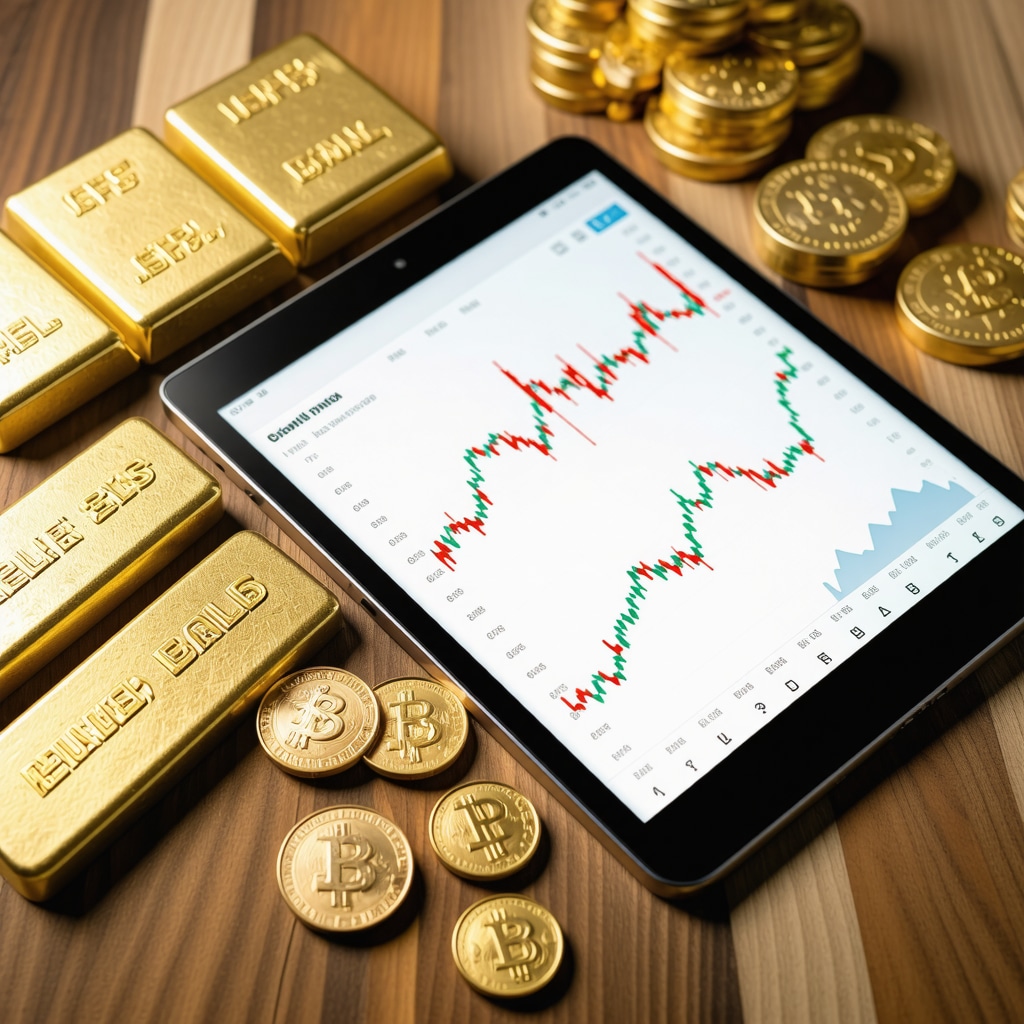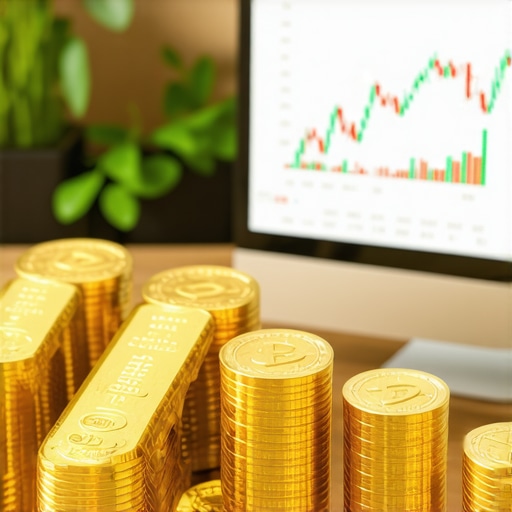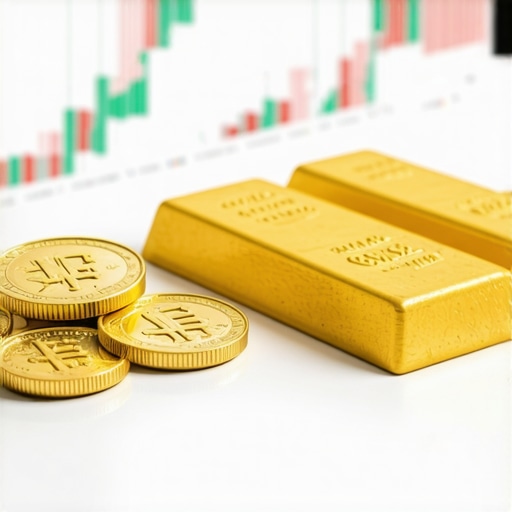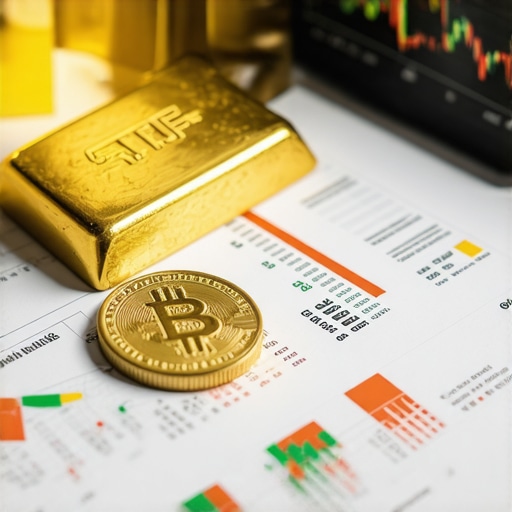Unlocking the Golden Spectrum: Diverse Paths to Investing in Gold
Gold has long captivated investors as a timeless store of value and a hedge against economic uncertainty. Yet, the spectrum of gold investments extends far beyond simply buying physical bars or coins. Today’s savvy investors can choose from a variety of gold investment vehicles, each offering unique benefits and risks tied to liquidity, storage, and market exposure. This guide delves into the nuanced types of gold investments — from bullion to ETFs — unraveling their complexities to empower your wealth-building decisions.
Physical Gold: Tangible Security in Bullion and Coins
Physical gold remains the archetype of gold investment, cherished for its intrinsic value and historical trust. Gold bullion bars and coins offer direct ownership of the metal itself, providing a tangible asset that can be held independent of financial systems. Investors often favor bullion for its purity and relatively low premiums, whereas gold coins carry numismatic value that can appreciate beyond metal content.
However, physical gold requires secure storage solutions and may incur higher transaction costs upon resale. For those focused on preserving wealth through tangible assets, exploring physical gold investment options is a prudent first step.
Gold ETFs: Liquid Exposure Without the Hassle of Storage
Exchange-Traded Funds (ETFs) specializing in gold have revolutionized access to the gold market. These funds track gold prices and trade on stock exchanges, enabling investors to gain exposure without owning physical metal. Gold ETFs provide exceptional liquidity, making it easy to buy or sell shares during market hours while avoiding the challenges of safekeeping.
While ETFs offer convenience and lower entry costs, they introduce counterparty risk and management fees. Understanding this balance is crucial for investors seeking a blend of accessibility and gold price correlation. For a comprehensive overview, consider reading about the top gold ETFs and mutual funds that blend growth with portfolio diversification.
Gold Mining Stocks and Mutual Funds: Betting on the Miners Behind the Metal
Investing in gold mining companies or mutual funds that specialize in mining stocks offers an indirect play on gold prices. These equities can amplify gains when gold prices rise but also expose investors to operational risks, geopolitical factors, and company-specific challenges. Unlike physical gold or ETFs, mining stocks can provide dividends and benefit from improved mining efficiencies.
Understanding the nuances of mining operations and market dynamics is essential here. For those intrigued by this avenue, exploring resources on investing in gold ETFs and mutual funds can provide deeper insights.
How Do Gold Futures Compare to Other Gold Investment Types?
Gold futures are contracts to buy or sell gold at a predetermined price on a future date, allowing investors to speculate on price movements or hedge against risks. Futures require sophisticated understanding and come with high leverage, which can magnify both gains and losses. Unlike physical gold or ETFs, futures are more suited to experienced traders comfortable with market volatility and margin requirements.
For beginners, it’s advisable to familiarize oneself with basics through guides such as the gold futures trading explained before venturing into this complex market.
Experience and Expertise: Real-Life Insights into Gold Investment Choices
Consider the case of an investor diversifying a retirement portfolio. Choosing physical gold bars provided a tangible hedge against inflation but required investing in a secure vault and insurance. Meanwhile, another investor leveraged gold ETFs for flexibility and liquidity, enabling quick portfolio adjustments in response to market shifts. These contrasting experiences highlight how individual goals and risk tolerance shape the optimal gold investment strategy.
Engaging with authoritative analyses, such as reports from the World Gold Council (gold.org), can further enhance understanding of gold’s evolving role in financial markets worldwide.
Join the Conversation
If you’ve explored different types of gold investments or have questions about the best fit for your financial goals, share your experiences or queries in the comments below. Together, we can deepen our understanding and make smarter investment choices.
Balancing Act: Weighing Risks and Rewards in Gold Investing
As I further reflect on my journey with gold investments, one key realization stands out: the importance of balancing risk tolerance with the nature of gold assets chosen. Physical gold offers peace of mind with tangible ownership, but it can tie up capital and requires vigilance in secure storage. Conversely, gold ETFs provide liquidity and ease, yet they expose you to market risks and management fees that chip away over time.
My experience taught me that diversifying across these options can hedge against the unique challenges each brings. For instance, holding a modest physical stash while maintaining ETF shares allowed me to adapt swiftly to market shifts without sacrificing the security that physical gold offers. This layered approach aligns with insights shared by the World Gold Council, emphasizing the value of combining gold investment types for a robust portfolio (gold.org research).
When to Consider Gold Mining Stocks: Personal Reflections and Practical Advice
Diving into gold mining stocks was a leap that initially intimidated me due to their inherent volatility and dependency on company performance rather than just gold prices. However, I found that with careful research and patience, these stocks can yield dividends and growth that physical gold alone doesn’t offer.
It’s worth noting that mining stocks often react to broader market trends differently than bullion or ETFs. For investors comfortable with stock market fluctuations, they can be an exciting way to leverage gold’s potential. I recommend exploring gold ETFs and mutual funds to gain exposure with reduced individual company risk.
Have You Explored the Impact of Global Gold Demand on Your Investment Choices?
One curiosity I often ponder is how global gold demand trends subtly influence the market beyond just price fluctuations. How do shifting demands from central banks, technology sectors, or emerging markets affect the strategies we choose? For anyone curious, understanding these trends can provide a strategic edge.
An informative resource I found particularly enlightening was the detailed analysis on global gold demand trends and their impact on prices. It helped me appreciate how these macro factors play out in everyday portfolio decisions.
Practical Tips for Safely Navigating Physical Gold Investments
From personal experience, investing in physical gold requires more than just purchasing the metal. It involves thoughtful consideration of storage, insurance, and verification of authenticity. I once encountered a close call with a dealer whose certifications didn’t quite add up, underscoring the importance of using trusted sources.
If you’re venturing into physical gold, I highly recommend reviewing guides on how to find trusted gold dealers and best practices for secure storage. These steps have saved me from potential pitfalls and ensured that my investment remains protected.
What about you? Have you faced challenges or discovered tips in your gold investment journey? Feel free to share your stories or questions in the comments below — I’d love to hear your experiences and keep this conversation going!
Strategic Hedging with Gold Futures: Leveraging Market Volatility for Portfolio Optimization
Gold futures contracts offer a powerful, albeit sophisticated, mechanism for investors aiming to hedge risk or speculate on price movements with amplified leverage. Unlike traditional gold holdings, futures require a nuanced understanding of margin requirements, contract expiration, and price volatility. Seasoned investors employ futures not only for directional bets but also to construct hedging strategies that mitigate exposure to currency fluctuations, inflation shocks, or geopolitical tensions.
For example, a portfolio manager anticipating inflationary pressures may take a long position in gold futures to offset potential losses in fixed income assets. However, the high leverage characteristic of futures amplifies both gains and losses, necessitating rigorous risk management protocols. As the CME Group’s educational resources emphasize, mastery over contract specifics and margin calls is essential before engaging in futures trading.
Unpacking the Role of Central Bank Gold Reserves: Implications for Market Liquidity and Price Stability
Central banks hold substantial gold reserves, which play a critical role in underpinning national financial stability and influencing global gold supply-demand dynamics. The strategies these institutions adopt—whether accumulation, sales, or leasing—can profoundly affect market liquidity and price trajectories.
In recent decades, coordinated gold sales or purchases by central banks have acted as catalysts for significant price movements. For investors, understanding central bank policies provides a strategic advantage in anticipating market shifts. For instance, increased gold buying by emerging market central banks often signals confidence in gold as a reserve asset amid currency volatility.
Analyzing reports by the International Monetary Fund (IMF Data and Reports) and the World Gold Council offers granular insights into these trends, empowering investors to align their portfolio adjustments with macroeconomic signals.
How Do Geopolitical Events Shape Gold Price Volatility and Investment Timing?
Gold’s status as a safe-haven asset means geopolitical tensions—ranging from trade conflicts to regional instabilities—can trigger rapid price fluctuations. However, the timing and magnitude of these responses depend on complex interactions between investor sentiment, currency markets, and global economic conditions.
For example, during acute crises, gold demand surges as risk-averse investors seek refuge, but prolonged conflicts may introduce supply chain disruptions affecting mining outputs and refining processes, further influencing prices.
Advanced investors monitor geopolitical developments alongside economic indicators to optimize entry and exit points, leveraging tools such as volatility indices and futures market positioning reports to anticipate shifts. Scholarly analyses, such as those published in the Energy Economics Journal, provide empirical data on these dynamics.
Integrating Sustainable and Ethical Considerations into Gold Investment Strategies
As environmental, social, and governance (ESG) criteria gain prominence, investors increasingly scrutinize the sustainability profiles of gold mining operations. Ethical sourcing, reduction of environmental footprints, and community engagement have become pivotal factors influencing not only reputational risk but also long-term asset performance.
Several funds now specialize in socially responsible gold investments, favoring companies that demonstrate transparency and adherence to rigorous ESG standards. Incorporating these considerations often entails analyzing third-party certifications and sustainability reports, thereby aligning investment portfolios with broader values without sacrificing returns.
This emerging facet of gold investing underscores the complexity of modern portfolio construction, where financial objectives intersect with ethical imperatives.
Engage Deeper: Exploring the Multifaceted World of Gold Investment
If you aim to refine your gold investment approach with advanced strategies or navigate the interplay between geopolitical factors and market dynamics, dive into our curated expert analyses and cutting-edge research. Join the dialogue by sharing your questions or insights below, and stay ahead in mastering gold’s intricate investment landscape.
Leveraging Quantitative Models to Forecast Gold Price Movements
For investors seeking a sophisticated edge, quantitative modeling techniques such as machine learning algorithms and time-series econometrics have become invaluable tools in predicting gold price trajectories. By incorporating variables like interest rates, inflation expectations, currency fluctuations, and geopolitical risk indices, these models deliver probabilistic forecasts that can refine timing and allocation decisions. However, the complexity and data intensity require robust computational resources and a deep understanding of statistical methodologies to avoid overfitting and ensure model robustness.
Integrating these quantitative insights alongside traditional fundamental analysis can elevate portfolio performance, especially in volatile market conditions.
Decoding Tax Implications and Regulatory Nuances in Gold Investment Vehicles
Understanding jurisdiction-specific tax treatments and regulatory frameworks is paramount for optimizing net returns from gold investments. Physical gold holdings may attract capital gains taxes differently than gold ETFs or mining stocks, with additional considerations such as VAT, import duties, and reporting obligations. Moreover, regulatory environments surrounding derivatives like gold futures can impose margin requirements and position limits that influence trading strategies.
Engaging with specialized financial advisors and staying abreast of evolving legislation ensures compliance and strategic tax planning, preserving investment gains.
What Are the Best Practices for Incorporating Gold into a Multi-Asset Portfolio to Maximize Risk-Adjusted Returns?
Incorporating gold into a diversified portfolio necessitates a nuanced approach balancing correlation dynamics, volatility profiles, and liquidity needs. Research suggests that a 5–15% allocation to gold, depending on macroeconomic outlook and investor risk tolerance, can enhance portfolio resilience against inflation and systemic shocks. Utilizing a combination of physical gold for capital preservation and liquid instruments like ETFs for tactical moves optimizes flexibility.
Dynamic rebalancing aligned with market signals and macroeconomic indicators can further improve risk-adjusted returns. Referencing frameworks from the CFA Institute (Financial Analysts Journal) provides authoritative guidance on portfolio integration strategies.
Harnessing Technological Innovations: Blockchain and Digital Gold Tokens
The emergence of blockchain technology has birthed digital gold tokens that represent fractional ownership of physical gold stored in secured vaults. These tokens promise enhanced liquidity, transparency, and 24/7 trading capabilities without the traditional hurdles of physical storage. Platforms leveraging smart contracts also enable automated audits and provenance verification, mitigating risks of fraud.
Though promising, investors should conduct due diligence on token issuers, regulatory compliance, and custody arrangements before adopting these novel instruments.
Exploring Macro-Economic Linkages: Gold as a Strategic Hedge in Inflationary and Currency Crisis Scenarios
Gold’s historical role as a hedge against inflation and currency depreciation remains relevant amid shifting global monetary policies. In periods of rising inflation expectations or depreciating fiat currencies, gold often exhibits inverse correlations with real yields, serving as a protective asset. However, the sensitivity varies across economic cycles and depends on investor sentiment, central bank interventions, and liquidity conditions.
Advanced investors monitor macroeconomic indicators such as the US Consumer Price Index (CPI), real interest rates, and foreign exchange reserves to fine-tune gold exposure dynamically.
Elevating Due Diligence: Assessing Operational and ESG Risks in Gold Mining Investments
Investing in gold mining companies requires thorough examination beyond financial metrics. Operational risks including mine depletion, cost overruns, and geopolitical instability can significantly affect profitability. Concurrently, Environmental, Social, and Governance (ESG) considerations increasingly influence company valuations and access to capital.
Utilizing ESG rating agencies and sustainability disclosures enables investors to identify mining firms with robust risk management and ethical practices, aligning financial goals with responsible investment principles.
Take the Next Step: Deepen Your Expertise and Refine Your Gold Investment Strategy
For those committed to mastering the multifaceted domain of gold investing, embracing a blend of advanced analytical tools, regulatory awareness, and ethical considerations is essential. Engage with the latest research, harness innovative technologies, and tailor your portfolio to evolving market dynamics.
Share your experiences or pose questions in the comments below to join a community of sophisticated investors navigating the golden frontier with confidence and insight.
Frequently Asked Questions (FAQ)
What are the main differences between physical gold and gold ETFs?
Physical gold entails owning tangible bullion or coins, offering direct asset control and no counterparty risk but requiring secure storage and higher transaction costs. Gold ETFs provide liquid, easily tradable shares that track gold prices without physical possession, but involve management fees and counterparty risk. Investors should weigh liquidity needs against security preferences when choosing between the two.
How can gold mining stocks complement a gold investment portfolio?
Gold mining stocks offer leveraged exposure to gold prices since company profits can increase disproportionately when gold prices rise. They also provide potential dividends and benefit from operational efficiencies. However, these stocks carry additional risks such as geopolitical instability and company-specific challenges, making them suitable for investors comfortable with equity market volatility seeking growth alongside gold price exposure.
What risks should beginners be aware of when trading gold futures?
Gold futures involve contracts to buy or sell gold at a future date with leverage, amplifying both gains and losses. Beginners face risks including margin calls, price volatility, and contract expiration complexities. Without sufficient market knowledge and risk management skills, futures trading can lead to significant financial losses, so it is generally recommended only for experienced traders.
How do central bank gold reserves influence gold market prices?
Central banks hold large gold reserves and their buying or selling activities impact global supply and demand dynamics. Coordinated sales can depress prices, while accumulation often signals confidence, potentially driving prices higher. Monitoring central bank policies helps investors anticipate market liquidity shifts and price stability trends.
What role do ESG considerations play in gold mining investments?
ESG factors are increasingly critical as investors seek mining companies with responsible environmental practices, social responsibility, and good governance. Firms with strong ESG profiles tend to have lower reputational risks and better long-term sustainability, which can translate into more stable financial performance and access to capital.
Can blockchain technology and digital gold tokens replace traditional gold investments?
Digital gold tokens represent fractional ownership of physical gold using blockchain, offering enhanced liquidity, transparency, and ease of trading. While promising, they still require due diligence regarding issuer credibility, regulatory compliance, and custody arrangements. They complement but do not yet fully replace traditional gold investment methods.
How should gold be incorporated into a diversified investment portfolio?
Typically, allocating 5–15% of a portfolio to gold can enhance diversification and hedge against inflation and systemic risks. Combining physical gold for capital preservation with liquid instruments like ETFs for flexibility allows investors to balance stability and agility. Dynamic rebalancing based on macroeconomic indicators further optimizes risk-adjusted returns.
What tax implications affect different gold investment vehicles?
Tax treatment varies widely by jurisdiction and investment type. Physical gold may incur capital gains and VAT, ETFs often have different capital gains rules, and mining stocks are taxed as equities. Futures contracts have their own tax considerations. Consulting with tax professionals is essential for compliance and optimizing after-tax returns.
How do geopolitical events impact gold price volatility?
Geopolitical tensions often increase gold’s appeal as a safe haven, leading to price surges during crises. However, prolonged conflicts can disrupt mining and supply chains, affecting availability and prices. Investors monitor geopolitical developments alongside economic indicators to time entries and exits effectively.
What advanced tools help forecast gold price movements?
Quantitative models using machine learning and econometrics analyze variables like interest rates, inflation, and geopolitical risk to forecast gold prices probabilistically. While powerful, these models require expertise and robust data to avoid overfitting. Combining quantitative insights with fundamental analysis enhances investment decisions.
Trusted External Sources
- World Gold Council (gold.org): Provides comprehensive research, market data, and analysis on gold demand, supply, and investment trends globally, serving as an authoritative resource for investors.
- CME Group Education (cmegroup.com): Offers detailed educational materials on gold futures and derivatives, essential for understanding complex trading instruments and risk management.
- International Monetary Fund (IMF) Data and Reports (imf.org): Supplies macroeconomic data and analysis on central bank gold reserves and their impact on global financial stability.
- CFA Institute Financial Analysts Journal (cfainstitute.org): Features peer-reviewed research on portfolio management strategies, including optimal gold allocation and risk-adjusted returns.
- Energy Economics Journal (journals.elsevier.com): Publishes empirical studies on the influence of geopolitical events and economic factors on commodity price volatility, including gold.
Conclusion
Investing in gold encompasses a rich array of options—from physical bullion and coins to ETFs, mining stocks, futures, and emerging digital tokens—each with distinctive advantages and challenges. Understanding these diverse vehicles allows investors to tailor strategies that align with their risk tolerance, liquidity needs, and ethical considerations. Central banks’ activities, geopolitical dynamics, and macroeconomic trends further shape gold’s performance, underscoring the value of informed, multifaceted approaches. Advanced tools, including quantitative models and ESG assessments, empower sophisticated portfolio construction and risk management. By integrating these insights, investors can harness gold’s enduring appeal as a strategic hedge and growth asset. Engage with this knowledge by sharing your perspectives, exploring related expert content, and applying thoughtful strategies to fortify your financial future with gold’s timeless strength.










